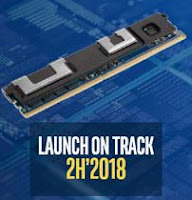This past week Intel announced more Optane SSDs for Client and Enterprise. These are nice products, faster than NAND based products in most metrics, and available at 2-3x the prices of NAND based products. But these products are not the highest and best use of 3D Xoint. And Samsung has announced competing products.
In a separate announcement, Navin Shenoy stated that Optane DIMMs will be available in servers in 2H 2018 and that the market could be $8B for Optane DIMMS in 2021. This is far higher than all other Optane or 3D Xpoint applications combined. Optane is meant for DIMMS.
Over the next few months, we will investigate and learn a few things that will confirm or reject that $8B opportunity that Intel announced.
- What is in a Optane DIMM? How much DRAM is onboard? That will determine the cost.
- How fast will an Optane DIMM be? People say it works at DDR4 speed. Is the speed really the same speed as DDR4 Server DIMMs?
- What will the price be? Some companies will want to max out server memory and Optane DIMMs will have high capacity. But most companies will make trade off decisions on price vs performance. Initial comment from Intel was "half the price". As long as its the same speed as server DRAM DIMMs that will be game changing. If its slower .... hmmm.
- What is the optimal DRAM DIMM to Optane DIMM ratio in a server configuration? 1:1? 2:1? 1:2? 1:12?
- How many applications will have been optimized for persistent memory by end of 2018? All of the above comments basically ignore the "persistence" aspect. NVDIMMs have been around for a while and only 1-2% of servers are using them. Will Optane change this?
Fortunately, we will have answers to all these questions before modules are available in 2H 2018. I am sure Intel will share all the details and specifics! Wait .... what??? OK... you will have to get the details from us instead.
Mark Webb
www.mkwventures.com






